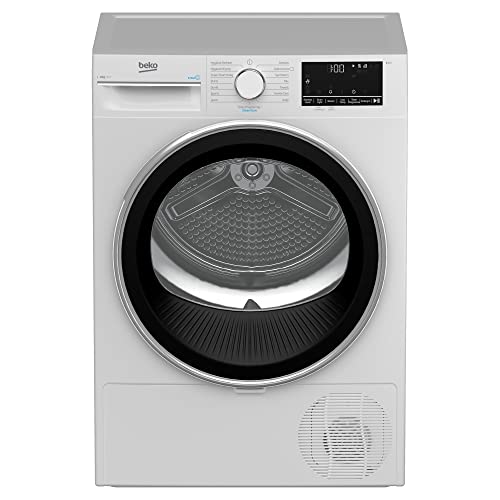Are You In Search Of Inspiration? Try Looking Up Tumble Dryers Heat

Tumble Dryers Heat Air to Dry Clothes
Tumble dryers warm the air inside them to dry the laundry. This helps to prevent textiles and clothing from being damaged by moisture.
Ventilated tumble dryers require a vent to let out the heated air. This is crucial to ensure that your tumble dryer can function properly and efficiently.
The newer models of heat-pumps don't require a vent to function, however they require a consistent flow of cool air. This will help them operate more efficiently and lower energy costs.
Low temperatures
The low heat setting is used to protect delicate fabrics and delicate materials from extreme heat. The setting is achieved by spinning the clothes to eliminate excess water instead of using the high temperature that dryers use when running the spin cycle. The knob for program selection on your tumble dryer allows you to choose the various settings before a cycle begins.
Certain garments might not be able to stand any heat, so you should always check the care label on each piece of clothing before putting it in the dryer. Fabrics that are designed for dry cleaning should never be placed in the dryer. The heat can cause them to lose their shape and eventually become damaged. Other fabrics can be dried using a tumble dryer, however the temperature should be lower than that typically used for cotton garments.
Gentle cycle or low heat are great for delicate fabrics like lace, chiffon, and sheer fabrics. This setting uses a small amount of heat to avoid shrinkage and stretching of the fabric and also reduce static. It's also a great choice for workout or activewear clothes made of spandex or other elastic fabrics since they are prone to melting and stretching when dried at higher temperatures.
Another setting for heat is the permanent wrinkle or press resistant setting. This setting produces a medium temperature, which is enough to dry the majority of fabrics without causing damage. This is a great option for cotton fabrics like cotton t-shirts and bath towels, however it is also a great option to dry other items of cotton that could break if exposed to high temperatures.

Certain tumble dryers also have a 'cotton setting' or "cotton dry" option, that is designed for heavy cotton fabrics such as bedding sheets and other linens. This setting is suitable for cotton clothing that won't easily shatter. However, it's generally advised to use a 'delicate cycle' or a 'tumble dry low' cycle.
Medium heat
The medium heat setting is less intense than the high heat setting, which makes it suitable for the majority of fabrics. Certain fabrics may shrink when dried at this temperature. So, make sure you check the care label or the manufacturer's instructions to determine the temperature recommended.
This setting will prevent shrinkage of cotton clothing, towels and bed sheets while maintaining their quality, texture, and color. The setting for medium heat is also safe for most synthetic clothing, like those made from polyester. It is recommended not to dry these fabrics on this setting if the fabric has specific instructions for drying and washing that suggest low or no temperature.
Other fabrics, such as silk and wool, could be damaged by the high temperatures of a tumble dryer's medium heat setting. If you're using this setting ensure that you adhere to the instructions for care of the garment and use a mesh laundry bag to protect delicate fabrics from snags during the tumble process. Also, if the fabric contains any embellishments or other decorations that could melt or become damaged during the drying process, you'll want to use a lower heat setting.
The high temperature of a tumbler can cause damage to spandex and other workout clothing. The "sportswear setting" on the majority of appliances will work well for these items as it helps maintain their shape and texture while reducing energy.
Based on the dryer's brand and model, the automatic and timed dry settings can use different amounts of heat than the normal heat setting. This is because the timed dry setting lets you set the amount of time you'd like your clothes to be in the dryer, while the regular or automatic cycle uses an indicator of moisture to determine when they're ready.
Some tumble dryers offer an option called 'cotton settings' that can be used to dry cotton garments like t-shirts and underwear. This setting isn't advised for delicate fabrics, as it will cause them to shrink and lose their shape and increase the chance of causing damage to other types of fabric.
High temperatures
Many tumble dryers come with a high heat setting that is ideal for heavier cotton fabrics. This setting helps dry items faster and prevents wrinkles, but it's not recommended for delicate or delicately washed clothing because the high temperature can cause them to shrink, fade or lose their shape. For example wool sweaters or silk dress shouldn't be tumble-dried as the high temperatures can damage the fabric. These garments should be dried with air to prevent any damage and shrinkage, and to maintain their softness and smooth texture.
Another setting that is popular with tumble dryers is the low heat setting which is ideal for delicate fabrics. The setting with the lowest heat is more gentle on fabrics than the medium heat setting. It also aids in reducing wear on fabrics. It also helps to preserve colors and reduces fade. It is a great choice for lingerie and knitwear as well as spandex workout clothing as well as sheer fabrics like lace or chiffon. The lower temperature settings will also help reduce the risk of allergens like pollen and pet dander that can trigger irritation or allergies in those with sensitive skin.
The medium temperature tumble dryer setting is typically used for synthetics and shirts like polyester. This is also a great option for robes and other things such as towels, sheets, or winter coats. It's crucial to know the labels on these clothes since some might require lower heat settings than others.
In addition, the heavy-duty cycle is designed for bulky laundry items that can stand up to high temperatures. This includes comforters, blankets and jeans. Also towels, robes, towels and winter coats. This setting is ideal for the majority of fabrics. However, if you want to safeguard expensive or delicate clothes, it's better to use a mesh bag. Additionally, some brands recommend using a dryer vent filter to ensure that the warm air isn't blowing directly on your clothes.
No heat
Tumble dryers use heat to stir and eliminate moisture from clothing. The dry air that is produced is either vented outdoors or collected by a condenser or heat pump or tumble dryer with an external vent.
Each type of tumbler has pros and pros and. While each of them is effective at drying laundry, it is important to know the differences between high, low and no temperatures so that you can select the right one for each load of clothes.
tumble dryer with heat pump is typically the highest temperature setting of your dryer, ranging from 125oF (52oC). This is ideal for items that require extra heating to dry faster, such as cotton sweatshirts and towels from a beach vacation. It's also the best choice for those who want to dry large items like bulky sweaters or jeans. The high setting is also perfect for towels and bedding because they are able to deal with the heat.
The low tumble dry setting typically is around 105oF (48oC) and is perfect for delicate, light fabrics like knitwear or sheers as well as workout clothing made from stretchy fabrics like lycra and spandex. It's also a great option for bras and lingerie that can be damaged by heat, as it prevents fraying, fading, wrinkling or stretching of the fabric.
Some tumble dryers have a no heat tumble dryer setting, which is typically room temperature and often called an air fluff cycle on your machine. This isn't ideal for all fabrics since it's intended to refresh and fluff up bedding or other bulky objects such as winter coats between washes. This method is not recommended for fabrics that cannot withstand heat, as they may be damaged or wrinkled by the lack heat.
Certain tumble dryers provide an anti-allergy option which operates at a temperature that is slightly higher, around 110oF (43oC). This is an excellent option for those with sensitive skin, as it helps remove dust particles and allergens that are accumulating. It's also a great option for those who suffer from respiratory issues. It can reduce wheezing and coughing that is common with allergies and asthma symptoms.
